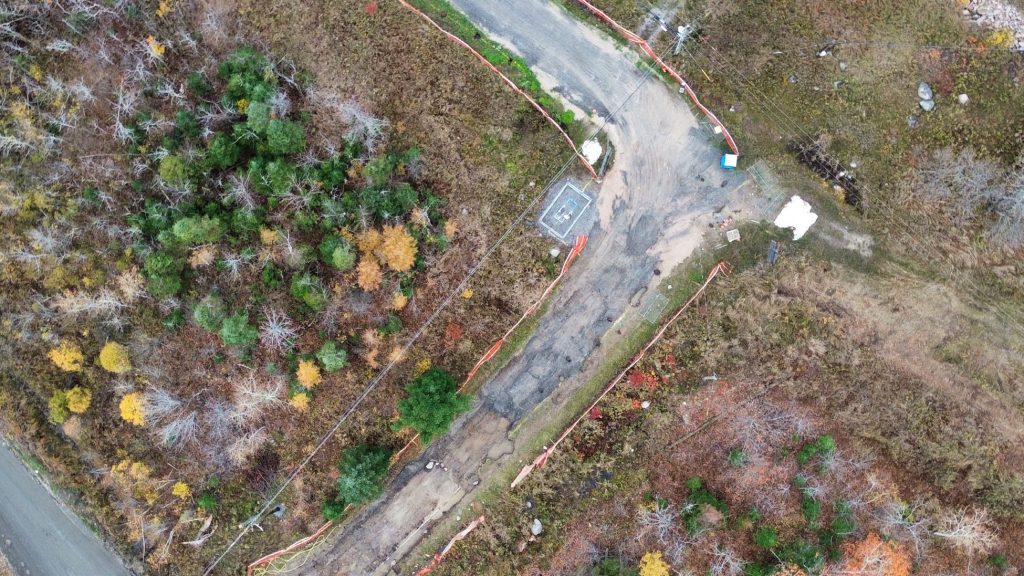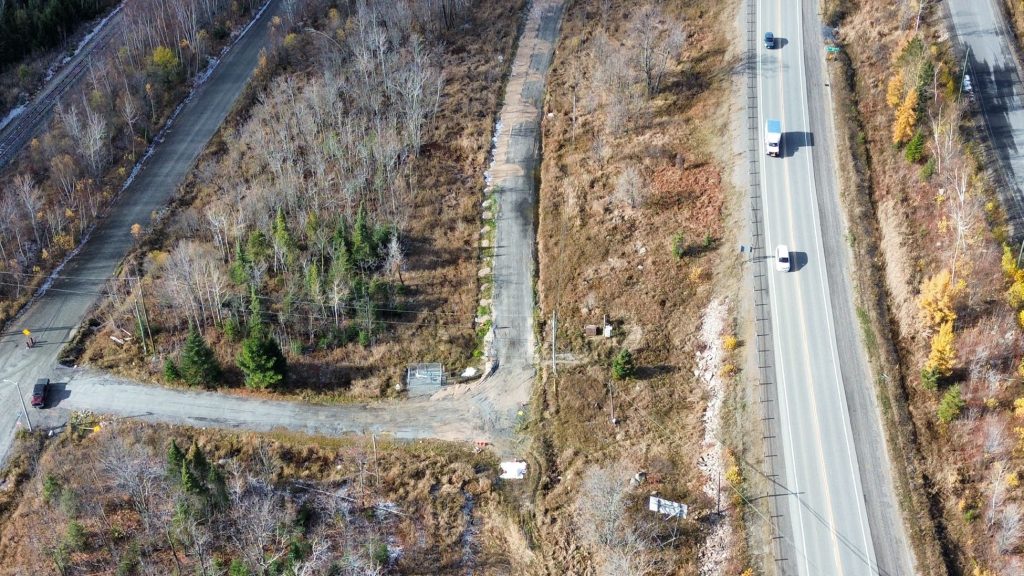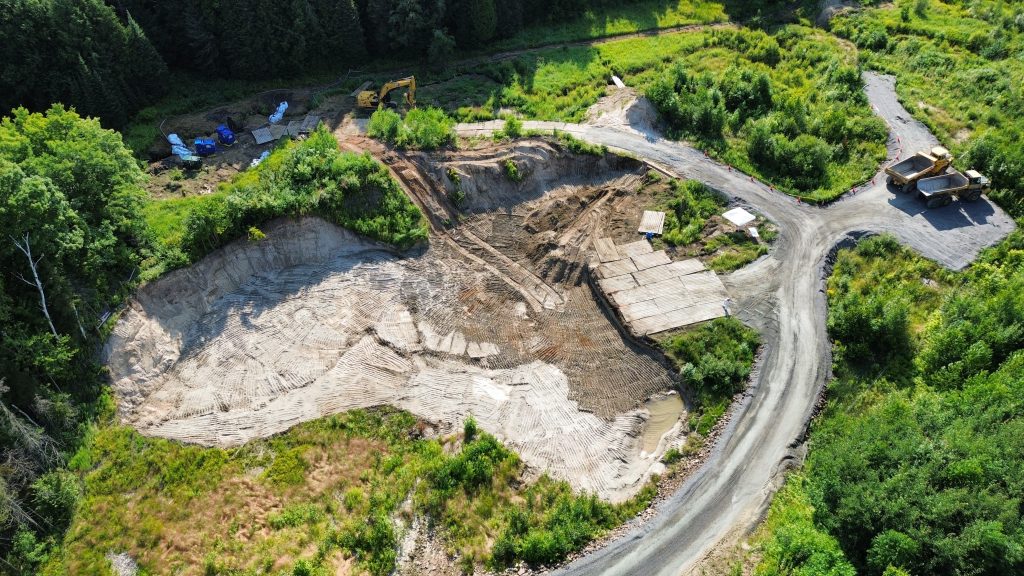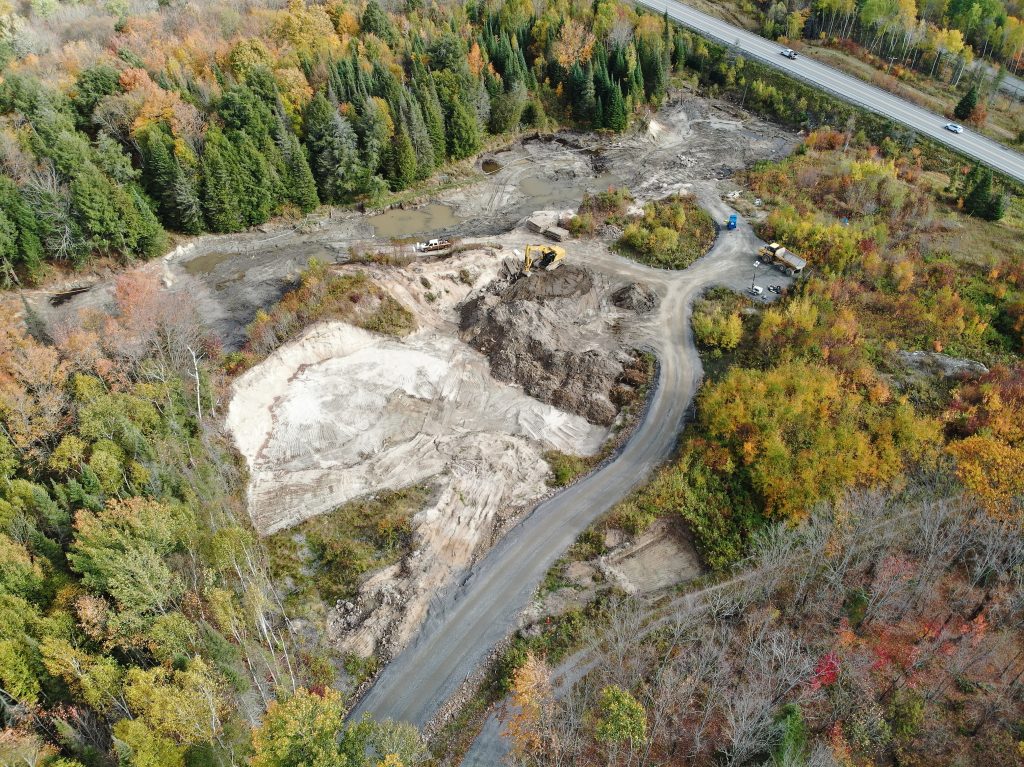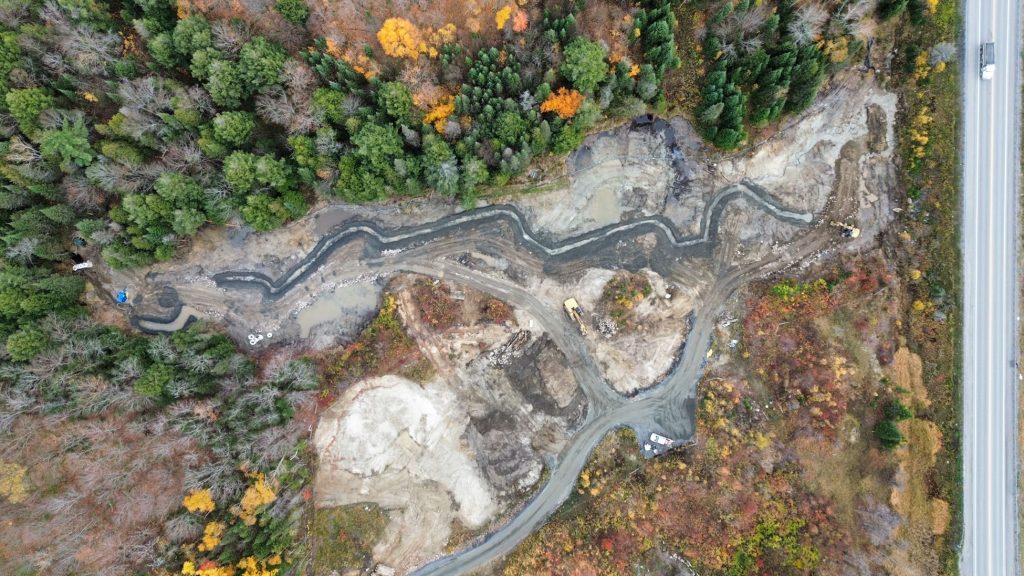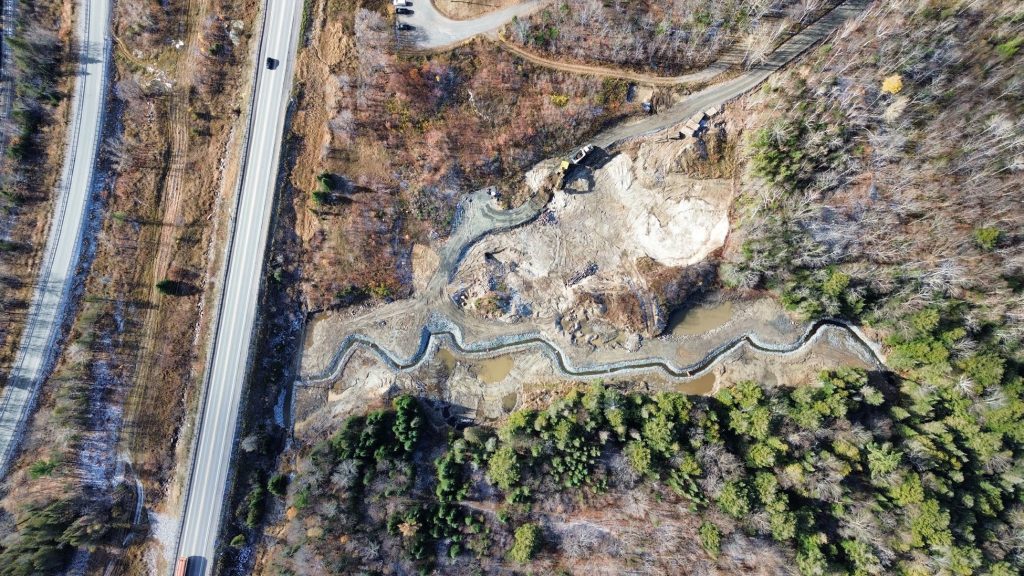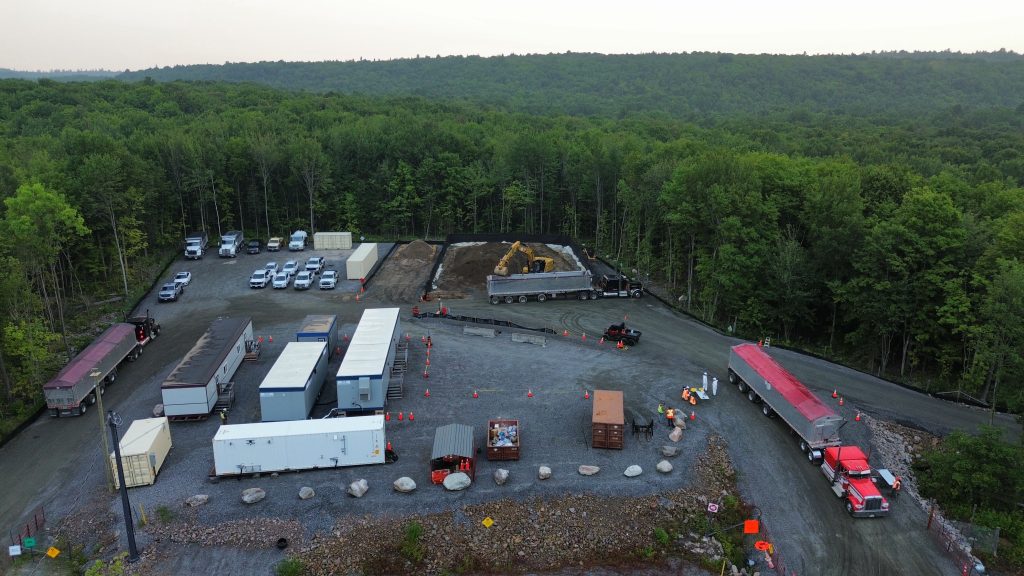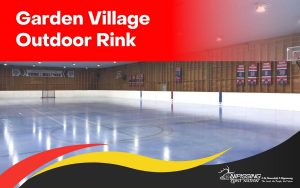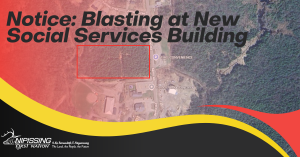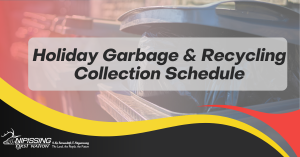Overview
The Soil Remediation Project resumed in April 2024 to remove niobium ore tailings from the former Nova Beaucage mill site in Yellek. The mill operated for just seven months in 1956, leaving tailings that were later deposited at the former gravel borrow pit north of Highway 17 (next to the Anishinabek Nation head office), and used in road construction and as fill at various sites on Nipissing First Nation during the 1970s and 1980s. These tailings contain low-level radiation from trace amounts of uranium in the ore. All impacted locations, including private residences, were identified through earlier investigations and are included in the remediation plan.
Current Status – November 2025
In July 2025, hauling operations resumed to remove the stockpile from Lot 24 in the Bineshii Business Park, and approval was granted for continued disposal at the Sarnia facility.
As of November 13, 2025, when the last truck left NFN, a total of 49,903.7 metric tonnes of Naturally Occurring Radioactive Material (NORM) has been excavated from all worksites and hauled away.
Crews are now busy demobilizing everything from the worksites and addressing final items before winter, such as removing silt and snow fences, gates and debris from the various worksites. The creek east of the Anishinabek Nation head office has been remediated, and excavation at the former Nova Beaucage mill site is complete with final remedial work to be completed in the spring to return it to a natural state. The future use of this site will be decided by Chief and Council in consultation with the community over the winter months.
We ask residents to continue avoiding the former mill site area. Although the major excavation work is finished, it remains an active construction zone, and perimeter fencing will remain in place due to ongoing safety hazards.
Local Procurement Summary
Nipissing First Nation has prioritized local participation throughout the soil remediation project to maximize community and economic benefits.
Fuel for the project is purchased from Arrowhead Gas Bar, while several NFN-based contractors are providing essential services on site. First North Enterprise and Young Forestry Services are leading much of the excavation and local trucking work, together representing about 70% of the on-site workforce (35% each). NFN’s own triaxle truck is also assisting with hauling contaminated material to the designated stockpile area.
In addition, SYCTR Electrical (Dokis member-owned business) is managing site facilities, providing cleaning, electrical, and water services, as well as maintaining lighting, cameras, and storage systems. Granular materials used for backfilling and site work are being supplied directly from the NFN Quarry and from Lot 21 in the Bineshii Business Park.
These local partnerships reflect NFN’s ongoing commitment to supporting community businesses, creating jobs, and building local capacity through major infrastructure projects.
Weekly Work Schedules (click on “Week of” to view details)
Week of November 17-21, 2025
Worksite #1 Operations (Former Mill Site)
- Monday-Friday:
- Clean up remaining silt fence and address deficiencies
Worksite #2 Operations (Former Nova Beaucage Road Allowance)
- Monday-Friday:
- Address any remaining deficiencies
Worksite #3 Operations & Laydown/Trail
- Monday – Friday:
- Clean access mats and remove them from site
- General site cleanup/demobilization
- Wednesday – Friday:
- Cut water to washrooms and remove from site
- Thursday – Friday:
- Move gates and dig ditches on the access road
245 Nova Beaucage Road
- All work completed until next year
Week of November 10-14, 2025
Worksite #1 Operations (Former Mill Site)
- Monday-Friday:
- No operations
Worksite #2 Operations (Former Nova Beaucage Road Allowance)
- Monday-Friday:
- Remove fence from WS 2.1
Worksite #3 Operations & Laydown/Trail
- Monday – Thursday:
- Continue load the Clean Harbors trucks to haul the contaminated material to the final disposal site – average of 18 trucks per day.
- Monday – Friday:
- Cleans access mats; general site clean up
245 Nova Beaucage Road
- All work completed until next year
Week of November 3-7, 2025
Worksite #1 Operations (Former Mill Site)
- Monday-Tuesday:
- Remove contaminated material from underneath loading/stockpile area and bring to WS #3 stockpile.
- Wednesday-Friday:
- Complete scans to ensure area is clear of all NORM material. Excavate if necessary.
Worksite #2 Operations (Former Nova Beaucage Road Allowance)
- Thursday-Friday: Clean fill for road and over pipeline from NFN Quarry.
Worksite #3 Operations & Laydown/Trail
- Lot 24 Staging Area
- Monday-Tuesday: Continue stockpile management and replenishing operations with material from WS #1.
- Monday-Friday: Continue loading the Clean Harbors trucks to haul the contaminated material to the final disposal site – average of 18 trucks per day (630 tonnes)
- Monday-Friday: Haul clean material to Lot 21 from NFN Quarry.
- Wednesday-Friday: Use material from WS #3.1 dry out zone to replenish stockpile.
- Creek Remediation Work
- Monday-Thursday: Maintain dewatering system and general site
- Thursday-Friday: Remove dewatering system and release all pumps and hoses.
- Monday-Friday: Continue creek rehabilitation using clean material from Lot 21.
245 Nova Beaucage Road
- Monday-Friday: Complete remediating excavated area with clean material from NFN Quarry.
Week of October 27-31, 2025
Worksite #1 Operations (Former Mill Site)
- Monday-Tuesday:
- Remove contaminated material from underneath loading/stockpile area and bring to WS #3 stockpile.
- Wednesday-Friday:
- Complete scans to ensure area is clear of all NORM material. Excavate if necessary.
Worksite #2 Operations (Former Nova Beaucage Road Allowance)
- Thursday-Friday: Clean fill for road and over pipeline from NFN Quarry.
Worksite #3 Operations & Laydown/Trail
- Lot 24 Staging Area
- Monday-Tuesday: Continue stockpile management and replenishing operations with material from WS #1.
- Monday-Friday: Continue loading the Clean Harbors trucks to haul the contaminated material to the final disposal site – average of 18 trucks per day (630 tonnes)
- Monday-Friday: Haul clean material to Lot 21 from NFN Quarry.
- Wednesday-Friday: Use material from WS #3.1 dry out zone to replenish stockpile.
- Creek Remediation Work
- Monday-Thursday: Maintain dewatering system and general site
- Thursday-Friday: Remove dewatering system and release all pumps and hoses.
- Monday-Friday: Continue creek rehabilitation using clean material from Lot 21.
245 Nova Beaucage Road
- Monday-Friday: Complete remediating excavated area with clean material from NFN Quarry.
Week of October 20-24, 2025
Worksite #1 Operations (Former Mill Site)
- Wednesday-Thursday:
- Remove contaminated material from boat launch area and remediate with clean fill from the Nipissing Quarry.
- Friday:
- Start removing remaining stockpile and top contaminated layer of work pad (to start when boat launch excavation and remediation is complete).
Worksite #2 Operations (Former Nova Beaucage Road Allowance)
- Friday: Contaminated earth excavation is complete. Clean fill will be completed after concrete removal in WS #1.
Worksite #3 Operations & Laydown/Trail
- Monday-Friday: Continue loading the Clean Harbors trucks to haul the contaminated material to the final disposal site – average of 20 trucks per day (700 tonnes)
- Maintain dewatering system and general site
- Use material from WS #3.1 dry out zone to replenish stockpile
- Continue stockpile management and replenishing operations with material from WS #1 and WS #2.1
- Haul clean material to Lot 24 from Nipissing Quarry
- Continue creek rehabilitation work using clean material from Lot 24.
245 Nova Beaucage Road
- Thursday-Friday: Start remediating excavated area.
Week of October 14-17, 2025
Worksite #1 Operations (Former Mill Site)
- Tuesday to Friday: No operations
Worksite #2 Operations (Former Nova Beaucage Road Allowance)
- Tuesday to Friday: Complete excavation around gas line with tinbin
- Scan 5-ton trucks leaving area to ensure the vehicles are clean
Worksite #3 Operations & Laydown/Trail
- Tuesday to Friday: Continue loading the Clean Harbors trucks to haul the contaminated material to the final disposal site – average of 18 trucks per day (630 tonnes)
- Maintain dewatering system and general site
- Use material from WS #3.1 dry out zone to replenish stockpile
- Continue stockpile management and replenishing operations with material from WS #1 and WS #2.1
245 Nova Beaucage Road
- Tuesday to Friday: Excavate cleared area
- Maintain dust on site using sprinklers and water truck
- Transport material from 245 to WS #3 stockpile with tarped triaxles
- Scan all triaxles leaving the area to ensure the vehicle has no contaminants on the outside
Week of October 6-10, 2025
Worksite #1 Operations (Former Mill Site)
Nipissing Miller worked with Young Forestry and First North Enterprise to load a total of 81 CH end-dump trucks with contaminated materials to be sent to the final disposal site.
- Monday to Friday: Continue contaminated earth excavation to fill stockpile
- Continue transporting material from WS #1 stockpile to WS #3 stockpile using tarped triaxles
- Maintain dust on site using sprinklers, water truck and dust fencing
- Scan all triaxles leaving the area to ensure the vehicles have no contaminants on the outside
- Move all contaminated concrete to stockpile to be shipped away with Clean Harbors trucks
Worksite #2 Operations (Former Nova Beaucage Road Allowance)
- Monday to Friday: Excavate around gas line with tinbin
- Scan 5-ton trucks leaving area to ensure the vehicles are clean
Worksite #3 Operations & Laydown/Trail
- Monday to Friday: Continue loading the Clean Harbors trucks to haul the contaminated material to the final disposal site – average of 18 trucks per day (630 tonnes)
- Maintain dewatering system and general site
- Excavate WS #3.2 North ++ to replenish stockpile, place material in WS #3.1 dry out zone
- Continue stockpile management and replenishing operations with material from WS #1 and WS #2.1
Week of September 29 – October 3, 2025
Worksite #1 Operations (Former Mill Site)
- Monday to Friday: Continue contaminated earth excavation
- Continue transporting material from WS #1 stockpile to WS #3 stockpile using tarped triaxles
- Maintain dust on site using sprinklers, water truck and dust fencing
- Scan all triaxles leaving the area to ensure the vehicles have no contaminants on the outside
- Prepare concrete foundation for removal
Worksite #2 Operations (Former Nova Beaucage Road Allowance)
- Monday to Friday: Re-Daylight gas line with tin bin and air lances
- Scan 5-ton trucks leaving area to ensure the vehicles are clean
- GTel on site in place of Enbridge to monitor and locate gas line
Worksite #3 Operations & Laydown/Trail
- Monday to Friday: Continue loading the Clean Harbors trucks to haul the contaminated material to the final disposal site – average of 18 trucks per day (630 tonnes)
- Maintain dewatering system and general site
- Excavate WS #3.2 North and replenish stockpile, place material in WS #3.1 dry out zone
- Continue stockpile management and replenishing operations with material from WS #1 and WS #2.1
- Scan limits of excavation to confirm no NORM is present
Week of September 22-26, 2025
Worksite #1 Operations (Former Mill Site)
- Monday to Friday: Continue contaminated earth excavation
- Continue transporting material from WS #1 stockpile to WS #3 stockpile using tarped triaxles
- Maintain dust on site using sprinklers, water truck and dust fencing
- Scan all triaxles leaving the area to ensure the vehicles have no contaminants on the outside
Worksite #2 Operations (Former Nova Beaucage Road Allowance)
- Monday to Friday: Continue excavation of WS #2.1 around gas line with Tinbin
- Scan limits of excavation to confirm no NORM is present
- Remove excavated material with tarped 5-ton truck
- Scan 5-ton trucks leaving area to ensure the vehicles are clean
- GTel on site in place of Enbridge to monitor pipeline
Worksite #3 Operations & Laydown/Trail
- Monday to Friday: Continue loading the Clean Harbors trucks to haul the contaminated material to the final disposal site – average of 18 trucks per day (630 tonnes)
- Maintain dewatering system and general site
- Excavate WS #3.2 North and replenish stockpile
- Continue stockpile management and replenishing operations with material from WS #1 and WS #2.1
- Scan limits of excavation to confirm no NORM is present
Week of September 15-19, 2025
Worksite #1 Operations (Former Mill Site)
- Monday to Friday: Continue contaminated earth excavation
- Continue transporting material from WS #1 stockpile to WS #3 stockpile using tarped triaxles
- Maintain dust on site using sprinklers, water truck and dust fencing
- Scan all triaxles leaving the area to ensure the vehicles have no contaminants on the outside
Worksite #2 Operations (Former Nova Beaucage Road Allowance)
- Monday to Friday: Continue excavation of WS #2.1 around gas line with Tinbin
- Scan limits of excavation to confirm no NORM is present
- Remove excavated material with tarped 5-ton truck
- Scan 5-ton trucks leaving area to ensure the vehicles are clean
- GTel on site in place of Enbridge to monitor pipeline
Worksite #3 Operations & Laydown/Trail
- Monday to Friday: Continue loading the Clean Harbors trucks to haul the contaminated material to the final disposal site – average of 18 trucks per day (630 tonnes)
- Maintain dewatering system and general site
- Continue stockpile management and replenishing operations
- Scan limits of excavation to confirm no NORM is present
Week of September 8-12, 2025
Worksite #1 Operations (Former Mill Site)
- Monday to Friday: Contaminated earth excavation
- Transport material in WS #1 stockpile to WS #3 stockpile using tarped triaxles
- Maintain dust fencing and silt fence
- Scan all triaxles leaving the area to ensure the vehicles are clean
Worksite #2 Operations (Former Nova Beaucage Road Allowance)
- Monday to Friday: Excavate contaminated material around gas line with tinbin
- Scan limits of excavation to confirm no NORM is present
- Remove excavated material with tarped 5-ton truck
- Scan 5 ton trucks leaving area to ensure the vehicles are clean
Worksite #3 Operations & Laydown/Trail
- Monday to Friday: Continue loading the Clean Harbors trucks to haul the contaminated material to the final disposal site – average of 18 trucks per day (630 tonnes)
- Continue stockpile management and replenishing operations
- Scan limits of excavation to confirm no NORM is present
Week of September 2-5, 2025
Worksite #1 Operations (Former Mill Site)
- Monday and Tuesday: Complete hand brushing WS #1 foundation
- Tuesday to Friday: Install/maintain dust fencing around perimeter
Worksite #2 Operations (Former Nova Beaucage Road Allowance)
- Tuesday and Wednesday: Install tinbin on excavator
- Wednesday to Friday: Excavate gas line with tinbin
- Tuesday to Friday: Scan limits of excavation to confirm no NORM is present
- Wednesday to Friday: Remove excavated material with tarped 5-ton truck
Worksite #3 Operations & Laydown/Trail
- Tuesday to Friday: Continue contaminated earth excavation at work site 3.4
- Continue loading the Clean Harbors trucks to haul the contaminated material to the final disposal site – average of 18 trucks per day (630 tonnes)
- Continue stockpile management and replenishing operations
- Scan limits of excavation to confirm no NORM is present
Week of August 25-29, 2025
Worksite #1 Operations (Former Mill Site)
- Monday and Tuesday: Brushing
- Tuesday to Friday: Install dust fencing around perimeter
Worksite #2 Operations (Former Nova Beaucage Road Allowance)
- Monday: Complete excavation of work site #2.1 using excavator
- Monday to Friday:
- Scan all triaxle trucks leaving the area to ensure the vehicles are clean
- Backfill excavation area with clean material
- Scan limits of excavation to confirm no NORM is present
- Wednesday to Friday:
- Install Dry Vac and start excavating within 1 metre of the pipeline
Worksite #3 Operations & Laydown/Trail
- Monday to Friday:
- Continue contaminated earth excavation at work site 3.4
- Continue loading the Clean Harbors trucks to haul the contaminated material to the final disposal site – average of 18 trucks per day (630 tonnes)
- Continue stockpile management and replenishing operations
- Scan limits of excavation to confirm no NORM is present
Week of August 18-22, 2025
Worksite #1 Operations (Former Mill Site)
- Operations are scheduled to commence at this work site once Worksite #3 and Worksite #2.1 are complete
Worksite #2 Operations (Former Nova Beaucage Road Allowance)
- Monday to Friday:
- Continue contaminated earth excavation operations
- Scan all triaxle trucks leaving the area to ensure the vehicles are clean
- Haul contaminated material to the Work Site #3 stockpile
- Backfill excavation area with clean material
- Scan material while excavating to confirm limits
- Use Dry Vac to excavate within 1 metre of the pipeline
Worksite #3 Operations & Laydown/Trail
- Monday to Friday:
- Continue contaminated earth excavation
- Continue loading the Clean Harbors trucks to haul the contaminated material to the final disposal site – average of 16 trucks per day (560 tonnes)
- Continue stockpile management and replenishing operations
- Scan limits of excavation to confirm no NORM is present
- Commence grading of excavated areas
Week of August 11-15 2025
Worksite #1 Operations (Former Mill Site)
- Operations are scheduled to commence at this work site once Worksite #3 and Worksite #2.1 are complete
Worksite #2 Operations (Former Nova Beaucage Road Allowance)
- Monday to Friday:
- Continue contaminated earth excavation operations
- Scan all triaxle trucks leaving the area to ensure the vehicles are clean
- Haul contaminated material to the Work Site #3 stockpile
- Potential to commence backfilling operations
Worksite #3 Operations & Laydown/Trail
- Monday to Friday:
- Continue contaminated earth excavation
- Continue loading the Clean Harbors trucks to haul the contaminated material to the final disposal site
- Continue stockpile management and replenishing operations
- Potential to commence grading of excavated areas
Nipissing Miller worked with Young Forestry Services and First North Enterprise to continue excavation operations at the Work Site #3 pit and to maintain the dewatering system. The dewatering led to the discovery of more NORM material in the bank of the old creek bed. All environmental precautions have been taken and the NFN Environment Manager has been engaged to assist with formulating the restoration plan.
Nipissing Miller also worked with Young Forestry and First North to load a total of 126 Clean Harbors end-dump trucks with contaminated materials to be sent to the final disposal site, and to complete all required site maintenance and install any new environmental measures as required throughout the project.
Week of August 5-8, 2025
Worksite #1 Operations (Former Mill Site)
- Operations are scheduled to commence at this work site once Worksite #3 and Worksite #2.1 are complete
Worksite #2 Operations (Former Nova Beaucage Road Allowance)
- Tuesday to Friday:
- Continue excavation of Work Site #2.1
- Scan all triaxle trucks leaving the area to ensure the vehicles are clean
Worksite #3 Operations & Laydown/Trail
- Tuesday to Friday:
- Continue contaminated earth excavation
- Continue loading the Clean Harbors trucks to haul the contaminated material to the final disposal site
- Continue stockpile management and replenishing operations
Week of July 28-Aug 1, 2025
Worksite #1 Operations (Former Mill Site)
- Operations are scheduled to commence at this work site once Worksite #3 and Worksite #2.1 are complete
Worksite #2 Operations (Former Nova Beaucage Road Allowance)
- Monday: Commence contaminated earth excavation operations
- Monday – Friday: Haul contaminated material to the WS#3 stockpile
- Monday – Friday: Potential to commence backfilling operations
Worksite #3 Operations & Laydown/Trail
- Monday to Friday:
- Continue contaminated earth excavation and potential to install the dewatering system
- Continue loading the Clean Harbors trucks to haul the contaminated material to the final disposal site
- Continue stockpile management and replenishing operations
Week of July 21-24, 2025
Worksite #1 Operations (Former Mill Site)
- Operations are scheduled to commence at this work site once Worksite #3 and Worksite #2.1 are complete
Worksite #2 Operations (Former Nova Beaucage Road Allowance)
- Monday: Complete clearing of vegetation throughout the site
- Tuesday: Reinstate/repair fencing and complete all site maintenance
- Wednesday to Friday: Complete daylighting of the Enbridge natural gas line
Worksite #3 Operations (Pit next to Anishinabek Nation Head Office)
- Monday to Friday:
- Continue contaminated earth excavation and potential to install the dewatering system
- Continue loading the Clean Harbors trucks to haul the contaminated material to the final disposal site
- Continue stockpile management and replenishing operations
Week of July 14-18, 2025
Monday, July 14
- Excavation begins at the former MTO borrow pit
- Rock trucks will transport material to Lot 24
- Clean Harbors trucks will haul material from Lot 24 to the approved facility in Sarnia
Tuesday to Friday (July 15- 18)
- 6:00 a.m. – 11:00 a.m.: Loading of Clean Harbors trucks at Lot 24
- After 11:00 a.m.: Continued hauling from the borrow pit to replenish Lot 24 stockpile
Timelines for Completion:
- Work Site #3 (next to Anishinabek Nation offices): COMPLETE
- Work Site #2 (former Nova Beaucage Road allowance): COMPLETE
- Work Site #1 (former mill site): Excavation complete, with final backfill, topsoil, seeding and landscaping to occur in Spring 2026
Work Completed in 2024
Remediation of four residential properties on NFN was completed in 2024, along with some work to remove contaminated material from the old Nova Beaucage Road allowance. The material excavated from these sites was stored on a vacant lot in the Bineshii Business Park through the winter.
In September 2024, NFN paused the excavation of any further contaminated material due to delays around receiving approvals to haul to the material to the Agnew Lake Tailings Management Area (ALTMA) or another approved disposal site.
NFN Work Sites & Disposal Plan
Disposal Site: Clean Harbors facility near Sarnia
The contaminated soil that will be removed from three work sites and the four identified private residences on NFN will be hauled to an approved and regulated disposal site.
Remediation Sites: Nipissing First Nation
Site #1: Former Nova Beaucage Mill Site – 15,539 tonnes of contaminated material to be removed, along with concrete pad foundation.
Site #2: Section of Nova Beaucage Road at the corner of Ernest Avenue (18 tonnes) and the old Nova Beaucage Road allowance (7,080 tonnes). This road allowance was not part of the original project scope, but we are committed to cleaning up this area.

Site #3: MTO Lands east of Anishinabek Nation head office – former gravel borrow pit (11,409 tonnes)

Private Residences: 224 tonnes in total ; two residences in Garden Village, one in Yellek, and one in Duchesnay.
All sites operate under Health and Safety Plans that exceed standard requirements to ensure community safety. Separate plans are in place for each work site and the disposal site. Refer to the Health and Safety Plan Summary for more information.
Community Engagement
Community information sessions were held on October 7, 2024, July 16, 2025 and September 15, 2025. Members are invited to contact the Business Operations Manager at any time at (705) 753-2050 ext. 1243 or [email protected] with any questions or concerns.
Resources
- Health and Safety Plan Summary – August 2025
- NFN Resident Information Package – Soil Remediation Project – July 15, 2025
- Frequently Asked Questions: Niobium Cleanup Project – Ontario Ministry of Transportation
- Canadian Nuclear Safety Commission Fact Sheet on Naturally Occurring Radioactive Material (NORM)
- EXP Presentation – Radiation Protection Program
- Project Briefing Presentation
Community Notices Archive
- Continuation of Work & Information Session – July 14, 2025
- Stockpile Removal Operations – June 25, 2025
- Winter Shutdown Notice – November 13, 2024
- Information Visits & Open House – September 20, 2024
- Project Update – April 16, 2024
Contact
For general project questions or concerns, please email [email protected] or call the Business Operations Manager at (705) 753-2050 ext. 1243.
For health and safety concerns:
Ray Alatalo, B.A.A. (Envir. Health), C.P.H.I. (C)
Environmental Public Health Officer for Indigenous Services Canada
705-698-4682
All other inquiries should be directed to [email protected].
“Irresponsible, historic actions have left Nbisiing with scars of contamination. In the 1950s, the Nova Beaucage Mill was built east of Yellek to process ore containing niobium and uranium. After only seven months of operation, the mill closed. Everything was left on site, and the radioactive, contaminated land was given back to us without any remediation. Radioactive materials from the mill were also stored at the Ontario Ministry of Transportation’s (MTO) abandoned sand pit on the north side of Highway 17. Unfortunately, ore stored at these sites was used for construction, landscaping, and roads in and around the community.” – from NFN Environmental Management Plan, Contaminated Sites Technical Tearaway
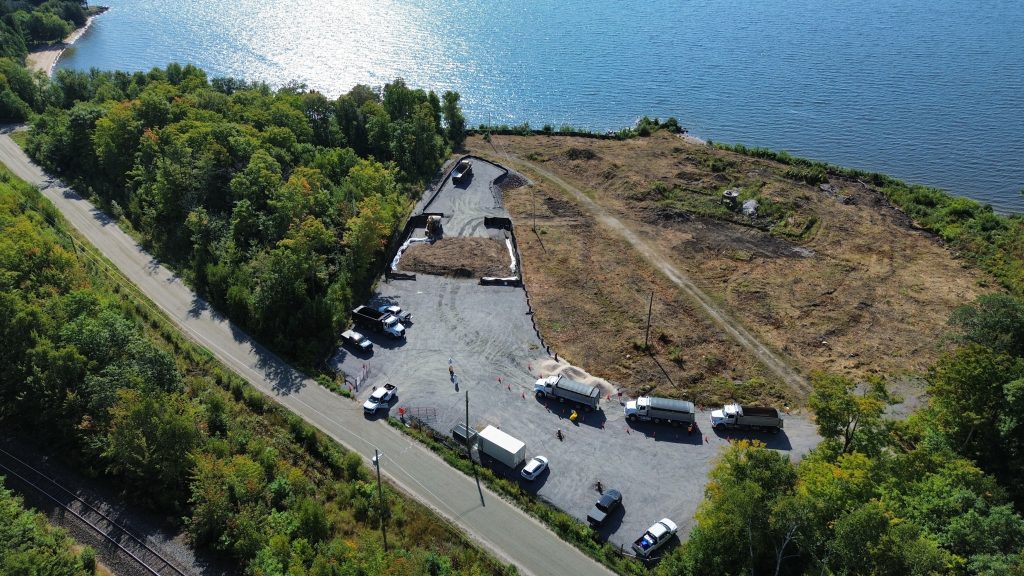

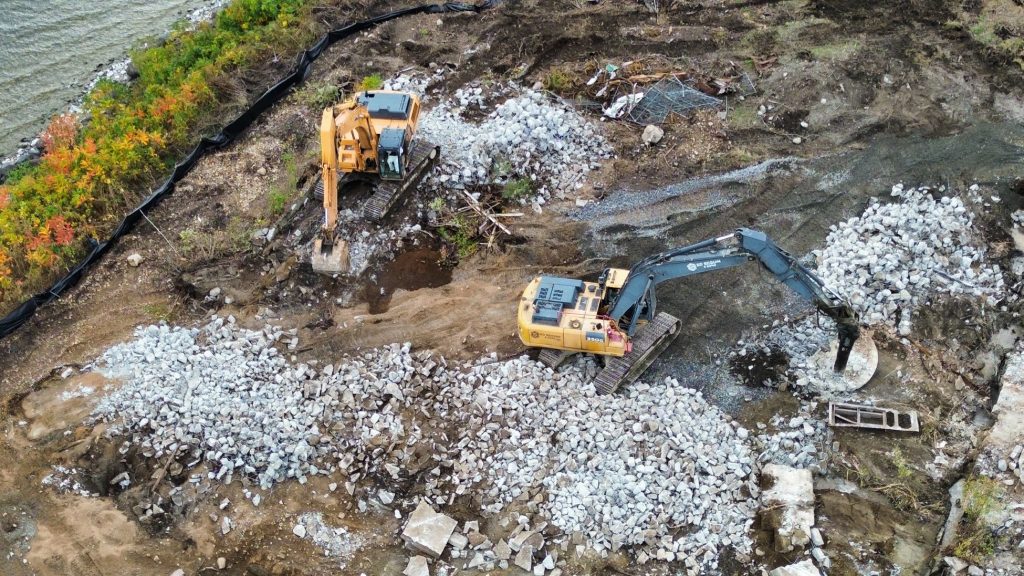
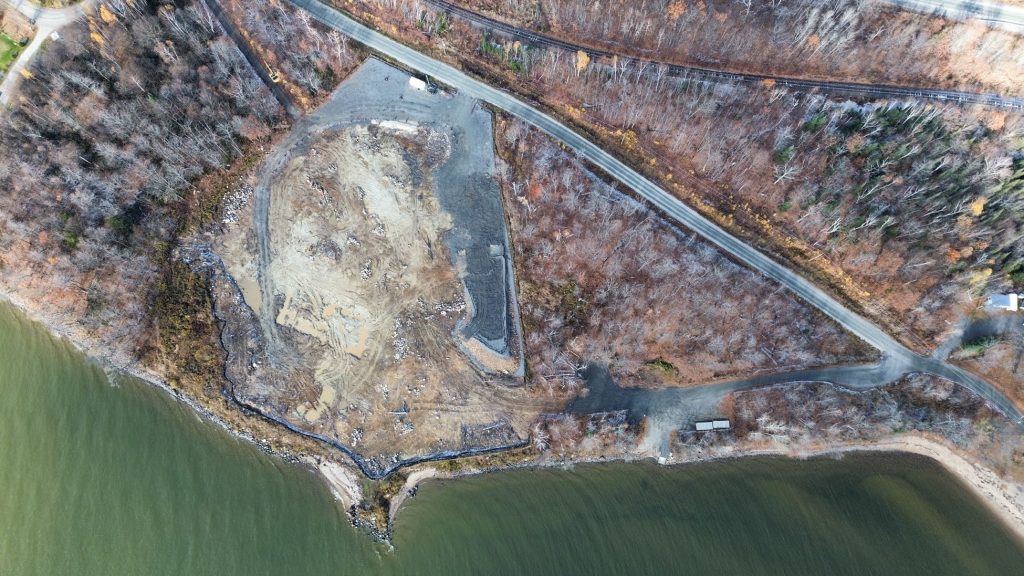
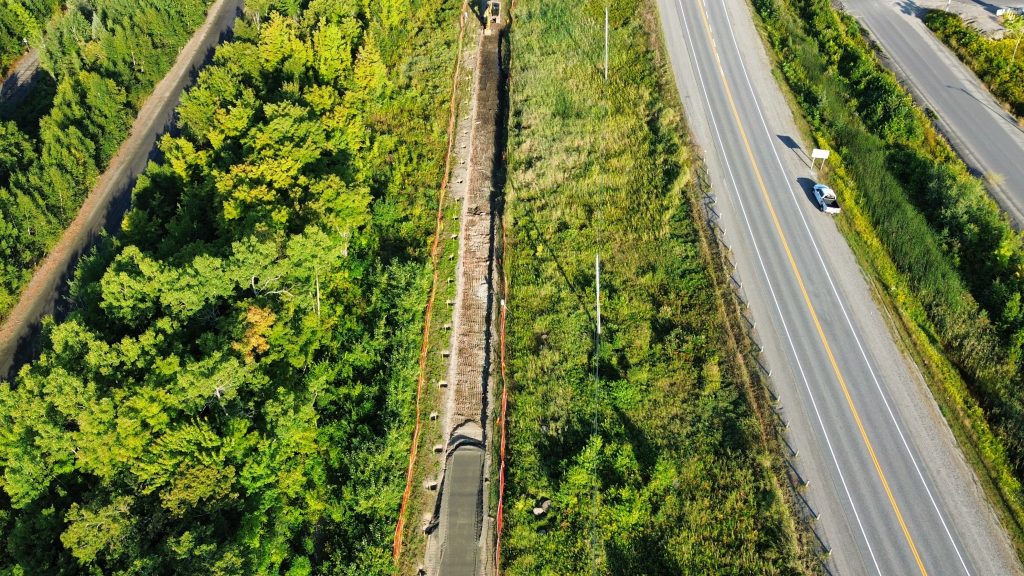
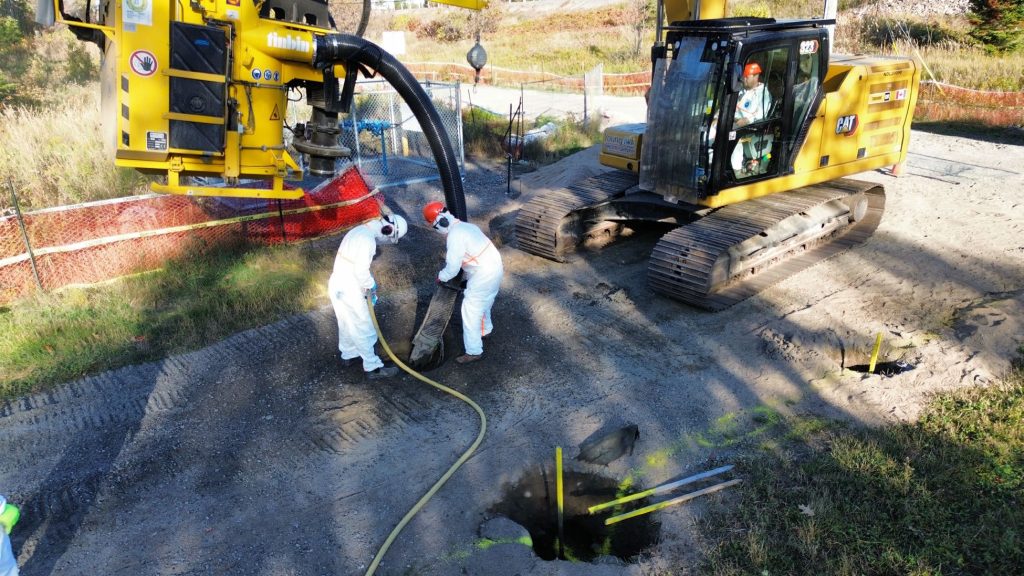
Work Site #2 (former Nova Beaucage Road allowance/Enbridge gas line) Tinbin in Action – October 2, 2025
